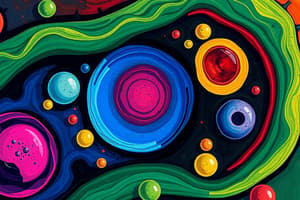Podcast
Questions and Answers
What are the primary components of the cell membrane?
What are the primary components of the cell membrane?
- Carbohydrates, nucleic acids, and steroids
- Lipids, cellulose, and cholesterol
- Proteins, nucleic acids, and phospholipids
- Proteins, lipids, and carbohydrates (correct)
Which statement correctly describes the structure of phospholipids in the cell membrane?
Which statement correctly describes the structure of phospholipids in the cell membrane?
- The phosphate end is hydrophobic and repels water
- Phospholipids are water-soluble and cannot penetrate the membrane
- Phospholipids form a lipid bilayer with hydrophilic heads outward (correct)
- The fatty acid portion is hydrophilic and interacts with water
Which of the following substances can easily penetrate the lipid bilayer of the cell membrane?
Which of the following substances can easily penetrate the lipid bilayer of the cell membrane?
- Glucose molecules
- Water-soluble ions
- Fat-soluble substances like oxygen (correct)
- Hydrophilic proteins
What role does the glycocalyx play at the surface of the cell?
What role does the glycocalyx play at the surface of the cell?
What is the main function of the endoplasmic reticulum?
What is the main function of the endoplasmic reticulum?
What is the primary function of the sodium-potassium pump in active transport?
What is the primary function of the sodium-potassium pump in active transport?
Which of the following accurately describes endocytosis?
Which of the following accurately describes endocytosis?
How do transport mechanisms relate to homeostasis?
How do transport mechanisms relate to homeostasis?
What characterizes the structure of a typical cell membrane?
What characterizes the structure of a typical cell membrane?
Which of the following is NOT one of the four types of tissues in the human body?
Which of the following is NOT one of the four types of tissues in the human body?
Flashcards are hidden until you start studying
Study Notes
Cell Structure
- The cell membrane is composed of proteins, lipids, and carbohydrates
- Lipids: Act as a barrier
- Proteins: Control substance passage and act as enzymes
- Cytoplasm: The clear liquid portion inside the cell that contains dissolved particles and organelles
- Cytosol: Cytoplasm plus dissolved particles and organelles
- Organelles: Structures within the cell that perform specialized functions
- Endoplasmic Reticulum (ER): Network of tubules and flat vesicles (ER is filled with endoplasmic matrix)
- Cell Cytoskeleton: Fibrillar proteins organized into filaments or tubules
- Actin Filaments: Found in the outer zone (ectoplasm), providing elastic support for the cell membrane
- Microtubules: Strong tubular structures composed of polymerized tubulin molecules
- Nucleus: Control center of the cell, containing DNA
- Nuclear Membrane (Nuclear Envelope): Two separate bilayer membranes, outer one continuous with ER
- Nuclear Pores: Openings in the nuclear membrane
- Nucleolus: Accumulation of RNA and proteins, no membrane, enlarges during protein synthesis
Cell Membrane (Plasma Membrane)
- Thin, elastic structure, 7.5 to 10 nanometers thick
- Basic structure is a lipid bilayer
- Composed of:
- Proteins (55%)
- Phospholipids (25%)
- Cholesterol (13%)
- Other lipids (4%)
- Carbohydrates (3%)
- Lipid Bilayer: Composed of phospholipid molecules with a hydrophilic phosphate end and a hydrophobic fatty acid portion
- Membrane Proteins:
- Integral Proteins: Channel, carrier protein, enzyme, receptor
- Peripheral Proteins: Enzymes
- Membrane Carbohydrates (Glycocalyx): Protrude to the outside of the cell, forming a loose carbohydrate coat
- Glycocalyx Functions:
- Negative electrical charge, repels other negatively charged objects
- Attachment between cells
- Hormone receptor
- Immune reactions
Transport of Substances Through Cell Membranes
- Diffusion: Movement of molecules from high to low concentration
- Simple Diffusion:
- Kinetic movement of molecules through a channel protein or lipid bilayer
- Occurs through the lipid bilayer (for lipid-soluble substances) or through channels (protein pores)
- Examples: Oxygen, nitrogen, carbon dioxide, alcohol
- Facilitated Diffusion: Movement of molecules across the membrane with the assistance of carrier proteins
Membrane Potential and Action Potential
- Excitable Membranes: Nerve and muscle cells that can rapidly change membrane permeability to Na+ and K+ by opening gated ion channels
- Action Potentials: Rapid changes in membrane potential that travel along nerve fibers
- Resting Stage: Polarization of the membrane with a negative potential (-90 millivolts)
- Depolarization Stage: Increased membrane permeability to Na+ ions, influx of Na+ neutralizes the negative potential, rising to a positive potential
- Repolarization Stage: Closure of Na+ channels and opening of K+ channels, rapid diffusion of K+ to the exterior re-establishes the negative resting membrane potential
Genetic Control of Protein Synthesis and Reproduction
- Genes: Nucleic acids (DNA) that control the formation of RNA
- RNA: Carries genetic information from DNA to ribosomes for protein synthesis
- DNA: Contains genetic information, double-stranded, contains thymine, self-replicating
- RNA: Synthesized by transcription, single-stranded, contains uracil
The Relationships of Chargaff
- The amount of adenine (A) equals the amount of thymine (T)
- The amount of guanine (G) equals the amount of cytosine (C)
Studying That Suits You
Use AI to generate personalized quizzes and flashcards to suit your learning preferences.




